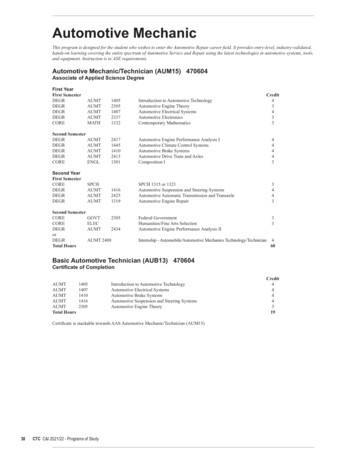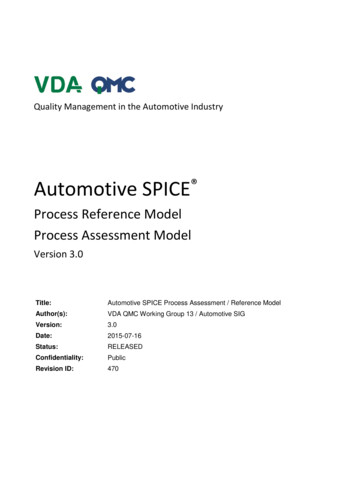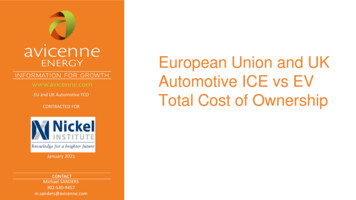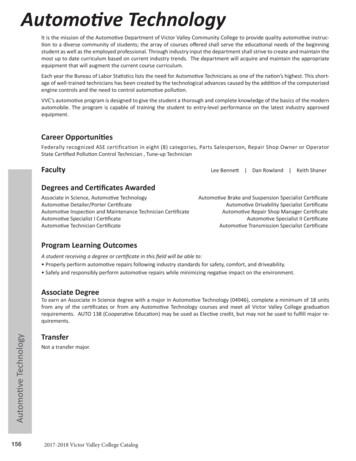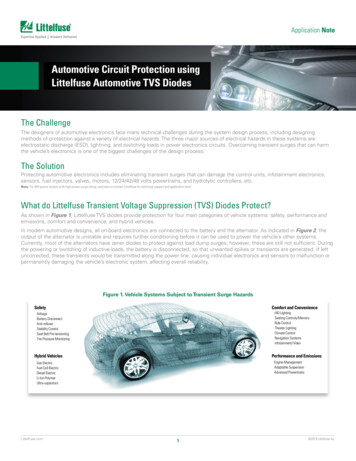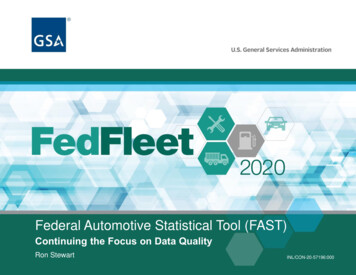
Transcription
Federal Automotive Statistical Tool (FAST)Continuing the Focus on Data QualityRon StewartINL/CON-20-57196:000
Overview of FAST and how vehicle fleet data is reviewed Preliminary review of FY 2019 fleet dataset How does it compare to prior year? Where are the trouble spots? Recommendations Discussion
What is FAST? Collaborative project funded and managed by GSA’s Office of Government-wide Policy DOE’s Federal Energy Management Program Energy Information Administration Collects multiple federal vehicle fleet datasets Vehicles & operational data (costs, miles, fuel) Fleet budget data Fueling infrastructure data
FAST: Why do we care about data quality? Based on how the data is used: Regulatory & EO compliance determination Required publications Policy evaluation and development Information resource for analysis Based on increased interest in Federal vehiclefleet inside and outside the government particularly since the transition to pervehicle reporting
FAST: Why do we care about data quality? Implications of questionable data quality Inaccurate compliance determination Decreased confidence in compliancedetermination Decreased confidence in dataset for other uses Policy development and evaluation Information resource for analysis Knowing where the potential quality concerns areis a key part of improving the quality
How is fleet data reviewed? As the data is reported: Data must pass validation as it is loaded 150 “blocking” checks for basic validity Data also screened for reasonability 25 “flagging” checks Checks are documented in FAST’s “Vehicle-LevelData Business Rules Reference”
How is fleet data reviewed? After it has been loaded in FAST: Pre-defined reports User-defined ad hoc queries
How is fleet data reviewed? When agency designates submission ascomplete: FAST team reviews agency submission FAST team provides written summary ofnoted items Agency responds to review summary FAST re-opened for corrections identifiedby agency FAST team assembles review results andagency responses into dashboard
How is fleet data reviewed? FAST team review looks at two levels Macro: high-level consistency with past data Unexpected shifts in fleet size or makeup? Inconsistent shifts in costs, miles, fuel? Micro: vehicle-level consistency and trouble spots Year-to-year consistency Fuel efficiency (e.g., mileage or fuel) Use of “placeholders” for vehicle information DOE review looks primarily at compliance Identifies issues impacting compliance
Preliminary review of FY 2019 fleet data Data call officially closed 2019-12-16 44 of 50 expected agencies completed on time 4 additional agencies complete before 2020-01-01 2 small agencies incomplete ( 60 vehicles) Preliminary review summaries provided to on-timeagencies shortly after completion First three agencies had summaries by 2019-11-15 Significant improvements: Agencies are reporting sooner Agencies are receiving feedback sooner
Preliminary review of FY 2019 fleet data Where do we see trouble spots? M1 & M7: Year-to-year consistency of vehiclereporting Missing / inconsistent reporting of vehicles Changes in “static” vehicle attributes M6: Fuel and mileage at the vehicle level M8: Use of “placeholder” values for vehicleattributes Particularly for vehicle fuel and mileage
Preliminary review of FY 2019 fleet data Trouble spots: Year-to-year consistency of vehiclereporting Measure 1(a): overall inventory (example) Total inventory discrepancies: 15,389 vehicles Measure 7(a): Current-year acquisitions alsoreported in prior year (flag OW-1.3) Total: 2,681 vehicles Measure 7(b): Vehicles in current-year inventorymissing from prior year (based on acquisition date;flag OW-1.4) Total: 23,800 vehiclesSource: FAST (https://fastweb.inl.gov/), 2020-01-13
Preliminary review of FY 2019 fleet data Trouble spots: Year-to-year consistency of vehiclereporting (continued) Measure 7(c): Prior-year disposals also present incurrent year (flag OW 4.4) Total: 1,104 vehicles Measure 7(d): Vehicles in prior year inventorymissing from current year: Total: 18,743 vehicles Measure 7(e): Vehicles with year-to-year changesto “static” attributes (flag A-1.5) Total: 114,680 vehiclesSource: FAST (https://fastweb.inl.gov/), 2020-01-13
Preliminary review of FY 2019 fleet data Trouble spots: Fuel and mileage at the vehicle level Measure 6: vehicles with invalid high fuel efficiency(flag F-4.6) Further limited to vehicles w/miles 1,000 Total: 40,465 of 581,798 vehicles 5 agencies with 10% of vehicles flagged Invalid data skews agency and federal pervehicle average fuel efficiencySource: FAST (https://fastweb.inl.gov/), 2020-01-13
Preliminary review of FY 2019 fleet dataSource: FAST (https://fastweb.inl.gov/), 2020-01-13
Preliminary review of FY 2019 fleet data Trouble spots: Placeholder values Placeholder: vehicle attribute which exactlymatches business rule thresholds for blocking orflagging data Raises question about “real” data 72,030 vehicles (of 698,441) reported with one ormore placeholder attributes 101,904 blocking placeholders 11,963 flagging placeholdersSource: FAST (https://fastweb.inl.gov/), 2020-01-13
Recommendations Maintain perspective: Understanding where the problems are is A GoodThing Improving quality is a (potentially lengthy) process Continue the focus on timely reporting Use available tools to identify, investigate problem areas Flags during data loading process Available reports Results from reviews (and supporting detail) Look for coming changes on the data collection side
FAST Program ContactsGSA OGP James VogelsingerEIA CES Cynthia Sirkjames.vogelsinger@gsa.gov Patrick .govFAST System Team Ron Stewartron.stewart@inl.govDOE FEMP Kendall Kam Michelle Kirbykendall.kam@ee.doe.gov Jay Wrobellmichelle.kirby@inl.gov Tim Raczekjay.wrobell@ee.doe.govtimothy.raczek@inl.gov @FASTdevs on Twitter
How is fleet data reviewed? FAST team review looks at two levels Macro: high-level consistency with past data Unexpected shifts in fleet size or makeup? Inconsistent shifts in costs, miles, fuel? Micro: vehicle-level consistency and trouble spots Year-to-year consistency Fuel efficiency (e.g., mileage or fuel)




